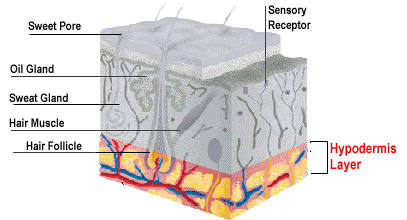
HAIR AND SCALP
All our body is covered in skin, its purpose is to protect and defend.
Skins is made up of three layers:

EPIDERMIS
The epidermis is the outer layer of the scalp and it is a tissue made up mainly of keratinocytes, with time the cells become saturated with a strong waterproof protein: keratin. Each part of our body has different degrees of thickness, for example, the palms of our hands and soles of our feet are pressure points and, as a consequence, their epidermal layer is very thick.
The epidermis is made up of 5 layers:
-
Stratum Corneum
-
Stratum Lucidum
-
Stratum Granulosum
-
Stratum Spinosum
-
Stratum Basale (Germinative)
Each of these layers represents a different state of cellular maturity, which all originate in the stratum basale. The stratum basale is the first of the 5 layers and it is here that cellular production takes place. After production the cells are forced upwards by other cells found in lower layers, as they move they become keratinized and finally reach the most external layer, here they form the Stratum Corneum and help protect the skin.
As the skin produces new cells, the old ones are eliminated after 28 days. The eliminated cells are called “DESQUAMATION”. This process, known as celullar turnover, takes place all the time. It takes 4 weeks before the cells in the STRATUM BASALE reach the STRATUM CORNEUM. The thickness of the EPIDERMIS is 0.1 mm (the same as that of a sheet of paper).
THE DERMIS
The Derimis is a connective tissue, its thickness varies and it is found immediately beneath the epidermis; it contains numerous structures, these are; blood vessels, many cells, sudoriferous glands, pilosebaceous follicles and nerve endings, which react to pressure, changes in temperature and to pain. CVollagen and elastin fibre are the principal components of the dermis and these guarantee skin resistance, suppleness and elasticity.

The dermis contains:
Sudoriferous glands: these control the body temperature.
Sebaceous glands: these produce sebum, secreted on the growing cells to lubricate and protect the hair.
Hair bulb: within the bulb the cells continue growing, developing and becoming stronger (keratinization), then they are pushed upwards through the follicle to reach the exterior.
Nerves: these are sensitive to touch and temperature.
Arrector pili muscles: these muscles are attached to the hair follicle walls.
Papilla: contains nerve endings and blood vessels which guarantee cellular activity.
The thickness of the dermis varies from 0.3 to 3 mm, depending on the part of the body, it is the connective tissue of the scalp. The dermis is responsible for elasticity, thickness and structure.
THE HYPODERMIS

The hypodermis subcutaneous adipose tissue lies below the dermis, its thickness depends both on the part of the body and on our individual body structure. It is an important reservoir of energy for our body.
